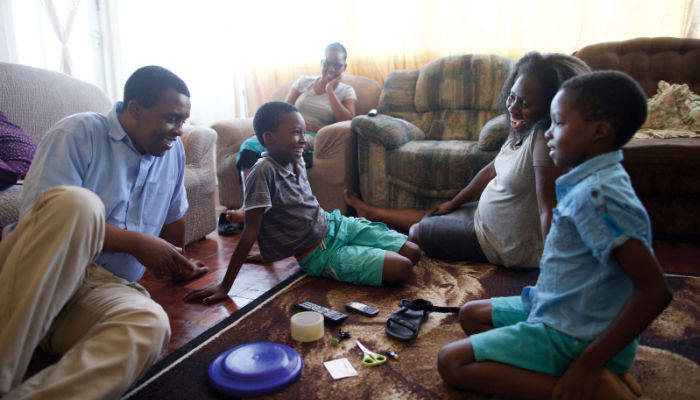
Why Women Don’t Wear Pants to Church
Dear Reader, I have a confession: I wear pants to church.
Sorry, I should clarify why this is a confession: I’m a woman and I wear pants to church.
If we’re just talking about style choices, I also like horizontal stripes, dangling earrings, and natural, wavy, hair. But this particular style choice is much more important than that.
Sure, you may be thinking what you wear to church is not important. We go to church to renew covenants. I agree! However, if what we wear is so insignificant, why does the sight of women wearing pants cause such a fuss in the first place? Believe me, it does.
In December of 2012, some Latter-day Saints staged “Wear Pants to Church Day”. One participant, Jamie Baydd, remarked in this article that it was designed to tell church members that “If you think you’re different…or if you feel there isn’t a place for you here, there is.”
Saints within and beyond the continental U.S. and Europe participated to raise cultural awareness. Women and men wore pants and the color purple to signify the inclusion of those who don’t fit “the classic LDS mold.” A Facebook page created afterward describes the movement as “an effort to normalize the action many LDS women have taken to wear formal, respectful dress pants to LDS church services”.
Though the movement was not aligned with a push for doctrinal change, it received criticism. Some members perceived the movement as unnecessary. Others said women who wear pants to church “don’t know how to follow the Lord”. One Bishop said these women didn’t know the meaning of liberation, and a woman online commented that they should leave and find another church. Finally, the Facebook group that garnered support for the event, “All Enlisted,” was eventually shut down due to a shooting threat.
Why is it a Big Deal?
Certainly, many members of The Church of Jesus Christ of Latter-day Saints do not care about women’s clothing at church, as focusing too much on something so superficial detracts from feeling the spirit and performing ordinances. To those members, I say this: I’m glad you think that! Indeed, For the Strength of Youth merely instructs us to “Show respect for the Lord and ourselves by dressing appropriately for Church meetings and activities.” Appropriately. Women in North America and Europe have worn slacks to job interviews, formal conferences, and even red carpet appearances since the 1960s.
Read “Mormon Feminist: Why I Need Feminism”
Plus, I thoroughly enjoy attending church in pants. I feel confident, I walk more comfortably, and I get lots of compliments, which usually lead to friendly conversations. Most of my experiences have been positive. However, that does not mean I haven’t felt anxious wearing them. Every time I walk to the pulpit, to my seat, or to a classroom I feel everyone’s eyes stop and linger as if I were breaking a rule.
When women at church talk to me about my pants, I sense a sort of forlorn admiration. One of my friends once looked me up and down, sighed, and said, “I would wear them too, but I don’t want to label myself or attract that much attention.” Whatever change did occur during the 2012 “Wear Pants to Church Day” wasn’t enough. Still, women feel inhibited by what the wardrobe choice would say about them.
An Interview
Despite all this, a remark about my church pants had never given me pause until I arrived at a temple recommend interview wearing slacks. I walked in, my Bishop looked me up and down, and he began to ask me the standard questions. In the middle of the interview, he looked at me concernedly and said, “Now, I have another question…it’s about your slacks. It’s fine if you wear them, but please tell me, are they a sign of rebellion?”
I furrowed my brow. What? Was this going to stand in the way of the temple?
I said no. “I just think they are cute and comfortable to wear. And church wardrobe standards only require that you wear your best. These pants are as formal as any of my dresses.” He nodded his head and finished with the scripted recommend questions. I wasn’t offended, I wasn’t hurt, but I was surprised.
Additionally, I had to ask myself: Were they a sign of rebellion? What was I trying to communicate by my appearance? Had I wanted to rebel I would do something that was actually against the rules of my faith, but that wasn’t it. I wanted to dress how I felt: powerful, confident, and unique. Why was that a sign of rebellion?
Perhaps you’re thinking, dear Reader, that it’s understandable to associate “Wear Pants to Church Day” with rebellion (i.e. members of Ordain Women or activist groups that seek to change LDS doctrine). I would agree. The goals of those groups overlap with the goal of the 2012 movement to include and uplift the voices on the outskirts of LDS culture. However, to assume that every woman who wears pants to church is rebelling against the laws we hold sacred is a mistake.
Appearance = Worthiness
I agree that members should come to the house of the Lord wearing whatever culturally communicates respect and reverence. I even understand why women didn’t wear pants to church in the 1960s when that was just barely becoming acceptable in mainstream culture. But, dear Reader, I don’t understand the reason why I’m writing this article, which is that women still don’t feel comfortable expressing themselves at church.
My bishop meant well, but his perspective proves that we have a problem. We too often mistake conformity for worthiness. I had scheduled the temple recommend interview in an effort to keep progressing in my testimony. I was glad to report that I was worthy and happy in the gospel. But all that led up to a question about my wardrobe, and why I looked different than everybody else.
As a woman, referenced in this article from December 2012 said, “When a rule is this pointless and this scary to break, it NEEDS to be broken.” If in every ward, a woman feels this uncomfortable using agency to express herself, there is a problem. And if this problem prevents people from feeling safe and accepted at church, we should do all we can to fix it, right?
And so they did in 2012, and in 2013. Maybe they’ll do it again. And maybe, dear Reader, we’ll all understand a little more and react a little differently.








